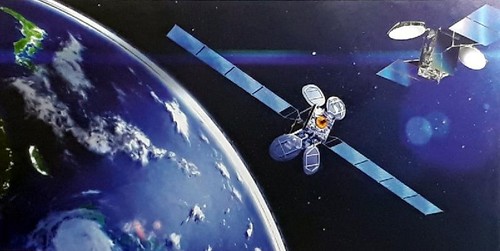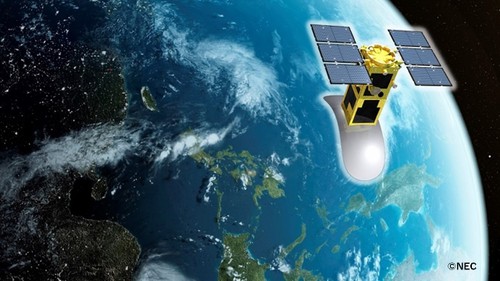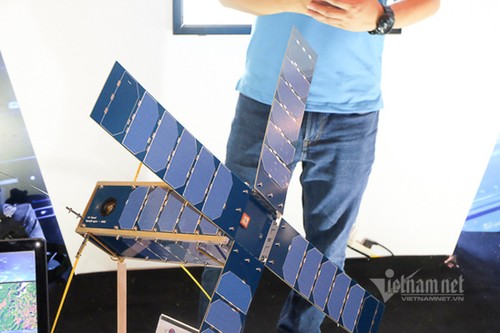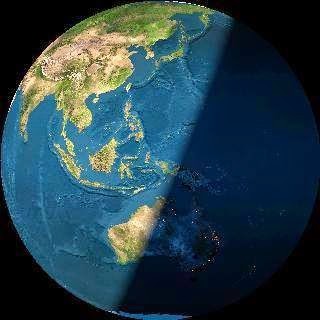B: Listeners who have been tuning to 7280 khz should switch to 11885 khz to listen to VOV. We are looking forward to receiving your feedback on reception quality on the new frequency.
A: Albert Patnongon asked us about the times and frequencies of VOV’s English service.
B: Thank you for you interest in our station. We’ll email you an updated frequency list for VOV’s English programs to make it easier for you to tune in to our channel.
A: Mr. Lai Yuanxing of Phnom Penh, Cambodia, told us that he tuned in to VOV’s program on March 2 using a Degen DE17 digital receiver with a built in radio antenna. He rated SINPO 54444 with overall reception good and clear enough to hear the program.
B: But Mr. Lai, you forgot to tell us the frequency you were tuned to. We hope to receive more detailed feedback from you soon.
 Vietnam launched its first VINASat-1 satellite into orbit in 2008. Vietnam launched its first VINASat-1 satellite into orbit in 2008. |
A: I’m reading an email from Sakae Onozawa of Japan, a regular listener of VOV’s Japanese and English programs.
B: Sakae Onozawa is a computer system engineer. His hobbies are shortwave listening and creating computational graphics.
A: He said: “I am always listening to VOV5’s Japanese broadcasts in Yokohama city. Today I was surfing on shortwave radio, and by chance I heard VOV's English program. The news on your broadcast is very important and interesting to Japanese listeners. And the Vietnamese pop music aired in the program was a great pleasure.”
B Thank you very much, Mr. Onozawa, for your enthusiasm and your detailed reception report for our program on March 16 on 20220 khz. It helps our technicians monitor our overseas broadcasts.
 Stimulated image of Lotusat-1 Stimulated image of Lotusat-1 |
A: Siddhartha Bhattacharjee of India asked us: “Does Vietnam have a space research organization?”
B: Yes. The key agencies are the Space Technology Institute, the Vietnam National Space Center, the Vietnam Aerospace Association, and the FPT Technology Research Institute. Vietnam’s first space activity occurred in 1980, when cosmonaut Pham Tuan visited the Salyut 6 space station as part of the Intercosmos program, making him the first Asian in space.
A: The Vietnam Space Technology Institute (STI) is B: The main functions of STI are to research space science and technology, develop Earth observation satellites, and carry out independent programs on remote sensing, GIS, and GPS for natural resource, environment, and disaster management.
A: Vietnam successfully launched its first commercial satellites, VINASat-1 and VINASat-2, into orbit in 2008. Since then Vietnam has launched other Earth observation satellites, including VNREDSat-1A and Lotusat-1.
 A model of NanoDragon satellite (photo: Trong Dat) A model of NanoDragon satellite (photo: Trong Dat) |
B: Most recently, NanoDragon, a miniaturised satellite developed by the Vietnam Space Centre has been sent to Japan for final testing before its launch into orbit next September.
A: VNSC Director said the 4-kilogram NanoDragon, a nanosatellite created under the national space technology program for the 2016-2020 period, was a step toward VN’s goal of mastering the technology to design and manufacture small satellites for earth observation.
B: Researching, designing, integrating, and testing the satellite was done entirely by Vietnamese scientists. The satellite’s mechanical structure and power supply were manufactured in Vietnam.
A: After being tested in a simulated space environment at Japan’s Kyushu Institute of Technology, NanoDragon will be returned to Vietnam to await its launch, scheduled for September to coincide with VNSC’s 10th anniversary.
B: NanoDragon will be carried into space by an Epsilon rocket and will orbit at an altitude of 520 kilometres.
A: NanoDragon will have two main tasks: monitoring marine vessels using an automatic identification system, and using an optical imaging device to verify the accuracy of the satellite’s orbiting position controller.
 The image of the earth taken by VINASAT-1 (photo: thienvandanang.vom) The image of the earth taken by VINASAT-1 (photo: thienvandanang.vom) |
B: Next we would like to read listeners’ comments on our program. Laurie Huesmann listened to our story on the Imago Work project that is creating a better future for people with disabilities.
A: She said: “It was a beautiful article. Thank you for highlighting this effort to bring flourishing to people with disabilities and those around them.”
B: The Latin phrase “Imago Dei” (“Image of God”) has been used to suggest that everyone, regardless of ability, ethnicity, gender, or social status, is created in the image of the Creator. They are born with dignity and the ability to work purposefully to contribute to a better world, even people with disabilities. Michelle Beard and her husband Michael, who have lived in Vietnam for 10 years, created the Imago Work project to help people with disabilities build a better future.
A: Michelle has four children. One of them, Evan, was born with Down syndrome in 1996. He was brought up the same way as his siblings, and later on went to a college for students with intellectual disabilities in the US. After graduation, Evan returned to Vietnam to work at his parents’ coffee shop, which is now a workplace for disabled people like her son.
B: The story “Persimmons – a specialty of Da Lat in Vietnam’s Central Highlands” caught the attention of Hossen Abed Ai and Hưngsmirth.
A: Hungsmirth said: “Thanks, VOV24/7’s English program. From now on, I have an place to listen to English and get a lot of interesting news of Vietnam.”
B: Thank you all for listening to VOV’s shortwave broadcasts and visiting our website. You can listen to specific stories or the whole program again on our website at vovworld.vn.
A: Thanks for listening to the Letter Box today. We always welcome your feedback at: English Service, VOVworld, the Voice of Vietnam, 45 Ba Trieu street, Hanoi, Vietnam. Or you can email us at: englishsection@vov.vn. You’re invited to visit us online at vovworld.vn, where you can hear both live and recorded programs.
A: Check out our VOV Media App, available on both the IOS and Android platform, to hear our live broadcasts. We look forward to your feedback on the mobile version of vovworld.vn. Once again, thank you all for listening. Goodbye until next time.